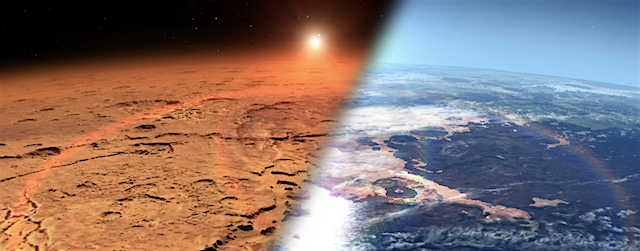 Solar wind and radiation are responsible for stripping the Martian atmosphere, transforming Mars from a planet that could have supported life billions of years ago into a frigid desert world, according to new results from NASA’s MAVEN (Mars Atmosphere and Volatile Evolution Mission) spacecraft led by the University of Colorado Boulder.
Solar wind and radiation are responsible for stripping the Martian atmosphere, transforming Mars from a planet that could have supported life billions of years ago into a frigid desert world, according to new results from NASA’s MAVEN (Mars Atmosphere and Volatile Evolution Mission) spacecraft led by the University of Colorado Boulder.
“We’ve determined that most of the gas ever present in the Mars atmosphere has been lost to space,” said Bruce Jakosky, principal investigator for MAVEN and a professor at the Laboratory for Atmospheric and Space Physics (LASP). “The team made this determination from the latest result, which reveals that about 65 percent of the argon that was ever in the atmosphere has been lost to space.”
Jakosky is lead author of a paper on this research published in Science on [March 31, 2017]. Marek Slipski, a LASP graduate student, co-authored the study.
MAVEN team members had previously announced measurements showing that atmospheric gas was being lost to space and that described the processes by which atmosphere was being stripped away. [See here, here, and here.] The present analysis uses measurements of today’s atmosphere to give the first estimate of how much gas has been removed through time. [More at links; NASA/Goddard infographic on martian atmospheric loss is here]








